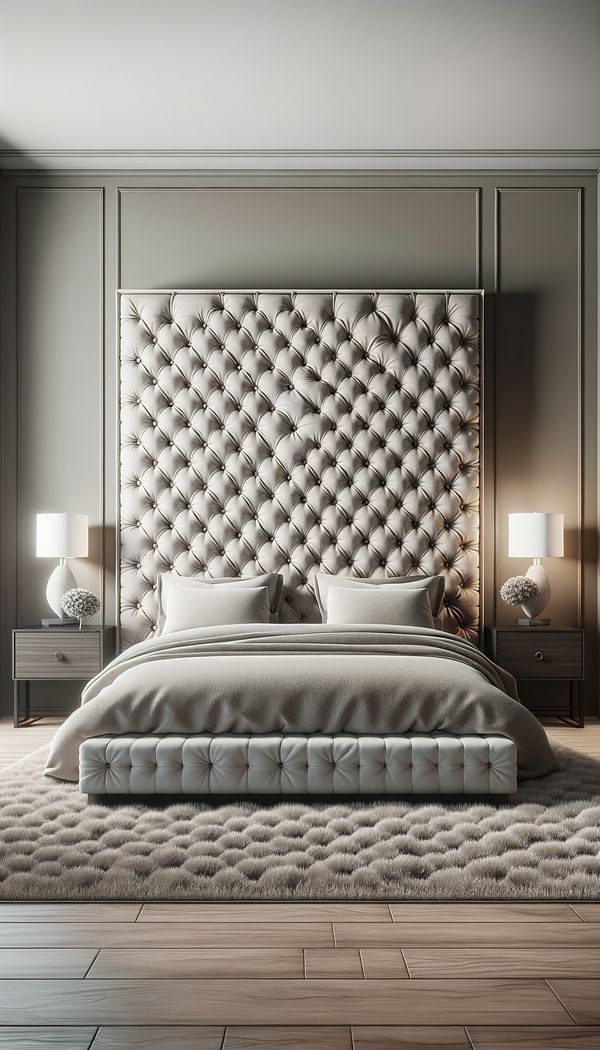What is a Headboard?
A headboard is a panel located at the head of a bed, often decorative and serving both aesthetic and functional purposes.
Description
A headboard, in the realm of interior design, is far more than just a piece of furniture; it's a statement piece that anchors the bedroom's decor. Positioned at the head of a bed, headboards come in a plethora of styles, materials, and sizes, making them versatile elements in bedroom design. Originally, headboards served practical purposes such as insulation and support, keeping sleepers warm by protecting them from drafts. Today, while they still offer support for sitting up in bed, their role has expanded to include a significant aesthetic aspect, contributing to the overall ambiance and style of a bedroom.
The variety of materials ranging from wood, metal, upholstered fabrics, and even wicker, allow headboards to fit into any design style, be it traditional, modern, or eclectic. Upholstered headboards, in particular, can add a layer of comfort and opulence, offering a soft surface to lean against. Meanwhile, wooden or metal headboards can complement a room’s architectural features or thematic elements. The choice of headboard can also influence the room's color palette, texture, and proportion, making it a key consideration in bedroom design.
Selecting the appropriate headboard is not just about finding a visually appealing piece but also about considering functionality and practicality. Some headboards come with built in storage solutions, such as shelves or compartments, which can be especially beneficial in smaller spaces. Moreover, headboards can range from floor-standing to wall-mounted varieties, providing flexibility in design and installation.
Usage
Headboards are commonly used in residential bedrooms, but are also found in hotels and guesthouses, offering an element of comfort and style. They are particularly popular in scenarios where the bedroom's aesthetic appeal is a priority. In luxurious or boutique accommodations, a headboard often acts as a focal point, featuring intricate designs, high-quality materials, or bold colors. In home design, a headboard can be a DIY project, allowing individuals to personalize their space further.
FAQs
-
Can a headboard be changed independently from the bed?
Yes, a headboard can often be changed independently from the bed. Many beds come with detachable headboards, allowing for easy replacement or update. This flexibility makes it simpler to refresh the bedroom's look without investing in a new bed.
-
Are there any specific measurements to consider when choosing a headboard?
When selecting a headboard, it's important to consider the width of the bed and the height of the ceiling. The headboard should not be wider than the bed frame and should be proportionate to the room's size. Tall headboards can work well in rooms with high ceilings, whereas shorter or slimmer designs may be better suited for smaller spaces.
-
Is it possible to customize a headboard?
Absolutely! Customizing a headboard allows for a unique addition to the bedroom that perfectly matches the desired style and comfort. Many companies offer customizable options, from the choice of material and color to the addition of storage spaces. DIY enthusiasts also frequently undertake the creation of their own headboard, tailoring it to their exact preferences.
Practical Application
To effectively incorporate a headboard into your bedroom design, start by considering the room's existing decor and the statement you want the headboard to make. Do you want it to stand out as a focal point, or complement the decor subtly? Once you've decided on the style, assess the practical aspects, such as size and materials, to ensure the headboard is both beautiful and functional. For those looking to make a bold statement, choosing an upholstered headboard in a vibrant color or pattern can add depth and texture to the room. Alternatively, a wooden or metal headboard can lend a timeless elegance or industrial flair, respectively. Lastly, remember that the headboard should enhance the comfort and ambiance of the bedroom, making it a welcoming and restful place.
-
Design Styles478 articles
-
Furniture Types599 articles
-
Decorating Principles & Elements330 articles
-
Textiles & Upholstery252 articles
-
Carlton TableA Carlton Table is a versatile piece of accent furniture characterized by its distinctive crossed-leg design.
-
SideboardA sideboard is a long, low piece of furniture used for storage and displaying items, traditionally found in dining rooms.
-
Kick PleatA kick pleat is a single, inverted pleat typically located at the back of a skirt or at the bottom of a slipcover or curtain to allow for more freedom of movement.
-
Design QuestionnaireA design questionnaire is a tool used to gather information from clients on their preferences, requirements, and goals for an interior design project.
-
ToneTone refers to the lightness or darkness of a color.
